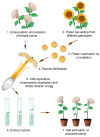The Production of Helianthus Haploids: A Review of Its Current Status and Future Prospects
- PMID: 36365372
- PMCID: PMC9654405
- DOI: 10.3390/plants11212919
The Production of Helianthus Haploids: A Review of Its Current Status and Future Prospects
Abstract
The genus Helianthus comprises 52 species and 19 subspecies, with the cultivated sunflower (Helianthus annuus L.) representing one of the most important oilseed crops in the world, which is also of value for fodder and technical purposes. Currently, the leading direction in sunflower breeding is to produce highly effective heterosis F1 hybrids with increased resistance to biotic and abiotic stresses. The production of inbred parental lines via repeated self-pollination takes 4-8 years, and the creation of a commercial hybrid can take as long as 10 years. However, the use of doubled haploid technology allows for the obtainment of inbred lines in one generation, shortening the time needed for hybrid production. Moreover, it allows for the introgression of the valuable genes present in the wild Helianthus species into cultivated sunflowers. Additionally, this technology makes it possible to manipulate the ploidy level, thereby restoring fertility in interspecific hybridization. This review systematizes and analyzes the knowledge available thus far about the production of haploid and dihaploid Helianthus plants using male (isolated anther and microspore cultures) and female (unpollinated ovaries and ovules culture) gametophytes, as well as by induced parthenogenesis using γ-irradiated pollen and interspecific hybridization. The genetic, physiological, and physical factors influencing the efficiency of haploid plant production are considered. A special section focuses on the approaches used to double a haploid chromosome set and the direct and indirect methods for determining the ploidy level. The current analyzed data on the successful application of haploid sunflower plants in breeding are summarized.
Keywords: androgenesis; distant hybridization; embryogenesis; gynogenesis; plant growth regulators; ploidy determination; shoot organogenesis; sunflower (Helianthus annuus L.); γ-irradiated pollen.
Conflict of interest statement
The authors declare no conflict of interest.
Figures





References
-
- Rauf S. Breeding Strategies for Sunflower (Helianthus annuus L.) Genetic Improvement. In: Al-Khayri J., Jain S., Johnson D., editors. Advances in Plant Breeding Strategies: Industrial and Food Crops. Volume 6. Springer; Cham, Switzerland: 2019. pp. 637–673.
-
- Atlagic J., Secerov-Fiser V., Marinkovic R. Interspecific Hybridisation and Cytogenetic Studies in Ornamental Sunflower Breeding. Aust. J. Exp. Agric. 2005;45:93–97. doi: 10.1071/EA01109. - DOI
-
- Fernández-Martínez J.M., Pérez-Vich B., Velasco L. Sunflower. In: Vollmann J., Rajcan I., editors. Oil Crops. Handbook of Plant Breeding. Volume 4. Springer; New York, NY, USA: 2009. pp. 155–232.
-
- Food and Agriculture Organization of the United Nations. [(accessed on 18 July 2022)]. Available online: https://www.fao.org/faostat/en/#data/QCL/visualize.
Publication types
LinkOut - more resources
Full Text Sources

